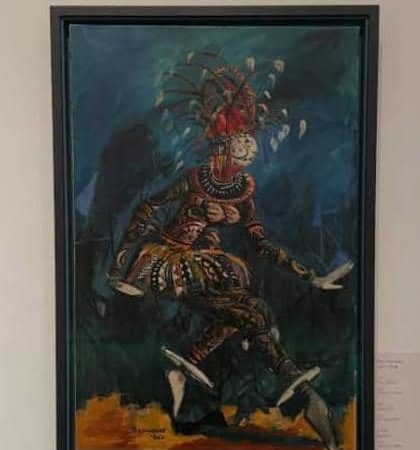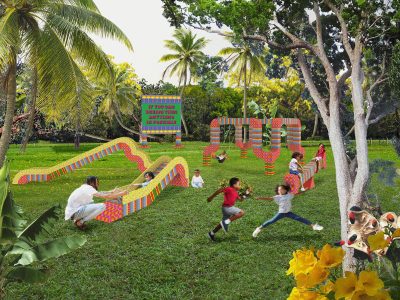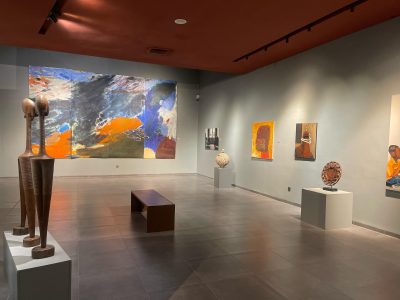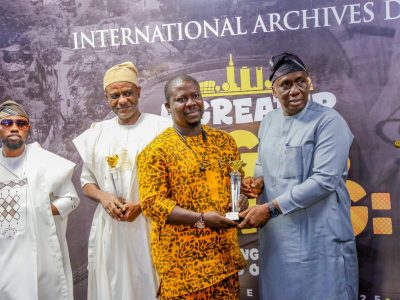Intro: The renovation of the iconic venue for FESTAC 77, National Theatre Iganmu has sparked concerns among the conservationists and artists. (Culled from THISDAY ARCHIVES)
An aerial shot of the National Theatre, a cultural masterpiece at Orile Iganmu Lagos is a compelling view-one that draws the viewer to the beauty in nature. But that was before the intrusion of caterpillars crushing through its mangroves. In an attempt to restore the glory of the facility with a massive renovation by the federal government through the Central Bank of Nigeria and Bankers’ committee, the wetlands had been destroyed.
The barely developed 44-acres around the military cap-styled facility constitute an eco-friendly environment for biodiversity. While much attention is paid to the state-of-the-art project that could potentially earn $20billion annually, the danger of eco-imbalance looms. From extreme flooding and natural disasters to loss of nature freshwater to sustain the fishing occupation, the anticipated sand-filling of these wetlands has been of concern to the interest groups and stakeholders.
It is against this background that the photo exhibition titled “Wetlands for Man and Biodiversity 2022” was organized recently by conservationists in collaboration with the National Theatre Management, Lekki Bird Club and the Nigerian Conservation Foundation. The show which features photographs that show different bird species, birds perching on water tables, environmental degradation occasioned by water pollution, debris on water table, pictorial fact sheets on how wetlands support species, livelihood and sustainability. One of the most outstanding of the images is that of a fisherwoman paddling with no sign of fish in sight.
Alongside these thought-provoking images were campaigns banners for Sustainable Development Goals (SDGs). They reveal bewildering facts about wetlands such as its role in providing 40% of the world’s species, mitigating the risk to people living with poor access to water and serving as a natural buffer against the increasing number of natural disasters in this era of climate change.
At the frontline of the fight against environmental degradation is Esther Nosazeogie, a research officer at Nigerian institute for Oceanography and Marine Research who spoke on the rationale for the exhibition at the opening on June 30.
“The wetlands here at the National Theatre are under threat,’’ she began. “The mangroves had been destroyed. There are plans to renovate the wetlands but we are worried that this may not be done sustainably. We have tried to reach out to those in charge and they have reassured us. But now, as you can see, the mangroves have been destroyed and they didn’t tell us what their plans are. This is not just a wetland. This is the hub of Nigerian culture. Moving the wetlands will not be helpful. When you destroy your wetlands, you cause biodiversity decline.
“Ijora is a hotbed of flooding. When the water comes, it goes to the table. That is the water we get when we dig the borehole. The wetlands perform functions that cannot be replaced. This exhibition is to raise the awareness on wetlands and help the public understand that our agitation is no mere hysteria. We are concerned about humans.’’
As for Dr. Shola Iwajomo, from the Department of Zoology, University of Lagos, who is a co-researcher on the project, preserving wetlands should be part of our cultural life in Nigeria. As a member of the Lekki Bird Club and UNILAG Bird Club, he found the exhibition thrilling as the pictures help the viewers to identify birds by their names.
“This exhibition is extended to school children so that they can learn about wetlands and their benefits. When we degrade the wetlands, we are losing aspects of our cultural lives,’’ he said.
In the same vein, the co-host, Your View on TVC, environmentalist and author of the children’s book, ‘Vultures to the Rescue: The Cleanup Crew,’ Mariam Longe drew a connection between the campaign to preserve wetlands and her own advocacy for vulture conservation.
“The story of environment is interconnected. I speak specifically on vultures and wildlife. But the wetlands are very important to us. Without wetlands, there are so many diseases that could be spread as a result of constant degradation and lack of proper conservation. It is important that people educate themselves because we, in Africa don’t have proper knowledge of wetlands. With events like this, we can move on to advocate for better policies to conserve our wetlands,’’ she said.
The Lekki Bird Club welcomes the renovation and development project at the National Theatre but hopes that the government as well as the Bankers’ Committee understand that development and sustainability are not mutually exclusive.


















